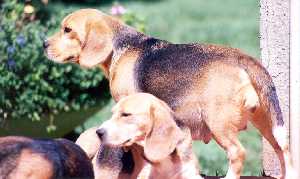The Breed's History
|
Those
little hounds have bibliographical origins, although they're few, in ancient
Greece. Since the 18th century, when they became popular in England as noble
hounds, due to their robustness, strenght, agility and sagacity, the beagles
grew a lot as a breed. At that time, they were often confused with the Harrier,
wich shows outstanding differences if compared to the beagle (specially concerning
their stature). The hunt afficcionates would rather follow hounds on foot,
and that's why they chose smaller dogs, with approximately 23 to 25 centimeters
of stature, starting from the witers (the line which is in the superior part
of the back, right above the shoulder, measured perpendicularly to the ground,
passing through the front paw).
|
|
what changes is the purpose of the nurturing. The americans tend to shows and exhibitions. On the other hand, the english focus on the hunt packs, attempting to preserve the original charactereistics of their dogs. But none of the two "ancestries" is exclusively for hunt or exibitions. In Brazil, the first registers of this breed date from the early 60's; they were brought by the creators Bento Soares Sampaio, Mrs. Serrador and René Mustardero. Although it is relatively young, the brazilians "stock" has always shown a very high level, due to their creators, which do a hard work of selection, nationally and internationally. |
|
Many varieties of beagles
are found in literature, such as the hard hair beagles (aramado?), the pocket
beagles or american or english ones. In fact, there are not too great differences.
All of them are beagles and what makes them different is only their growing
up, their "lineage", whichacquires certain characteristics determinated by
the surrounding atmosphere and by their owner's necessities (show, hunting
or just company). About
the american or english beagles,
|
